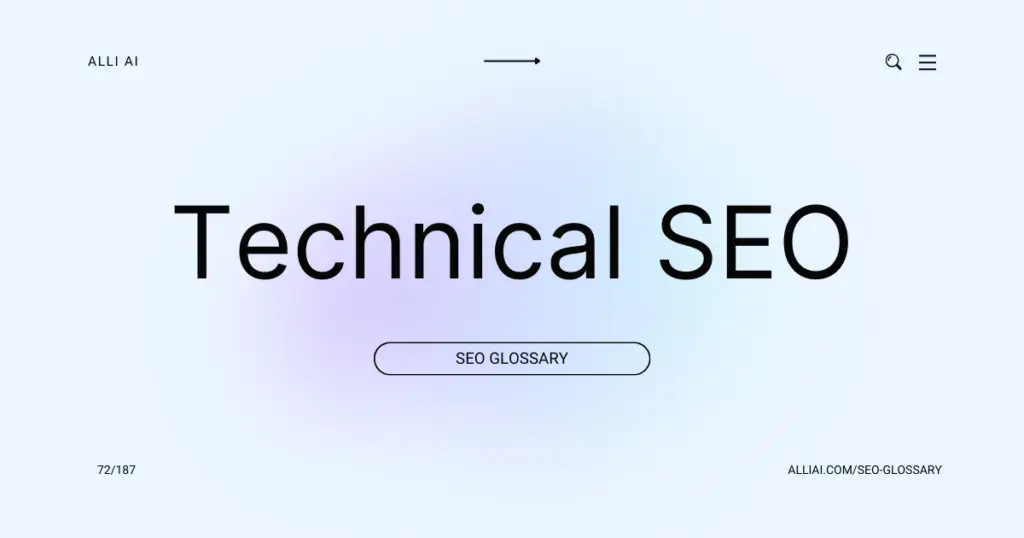What Does Technical SEO Mean?
Technical SEO refers to the process of optimizing the infrastructure of a website so that search engines can crawl and index it effectively. This includes aspects like site speed, URL structure, security protocols (such as HTTPS), mobile responsiveness, and the management of duplicate content. The goal is to ensure the technical setup of a site enhances its visibility and ranking in search engine results.
Where Does Technical SEO Fit Into The Broader SEO Landscape?
Technical SEO is a component of SEO focused on optimizing the infrastructure of a website so that search engines can crawl, index, and render it effectively. It covers aspects such as site speed, mobile responsiveness, URL structure, site architecture, structured data, security (HTTPS), and canonical URLs. This facet of SEO ensures that the website meets the technical requirements of modern search engines with the goal of improved organic rankings. It works in coordination with on-page SEO, which optimizes content and HTML source code, and off-page SEO, which involves external signals like backlinks. Together, these elements encompass the full spectrum of SEO strategies necessary for ranking well in search engine results pages (SERPs).
Real Life Analogies or Metaphors to Explain Technical SEO
Technical SEO is like the foundation of a house. Just as you need a strong, stable foundation to keep a house upright and functional, you need solid technical SEO to support and sustain a website’s structure. Everything else—like content and design—is built upon this base.
Technical SEO can also be compared to tuning a car’s engine. It involves optimizing the engine (the website’s backend) so that the car (website) runs smoothly and efficiently, ensuring that it can race against other cars (compete in search rankings) effectively.
Imagine Technical SEO as the backstage crew of a theater. They’re the ones who manage the lighting, sound, and stage setups that the audience never sees but without which the show could not go on. They ensure that the play (website) runs flawlessly, providing a seamless experience for the audience (users).
Technical SEO is like the circulatory system of the human body. It ensures that essential elements (like blood in the body or data on a website) flow smoothly and reach all the right places on time. A blockage or malfunction can cause the system (or website) to perform poorly.
How the Technical SEO Functions or is Implemented?
1. Crawlability and Indexing
– Robots.txt: Ensure it allows search engines to access important content and excludes areas not meant for indexing.
– XML Sitemaps: Create and submit an updated sitemap to search engines to aid in discovering all valid URLs.
2. Site Speed
– Compression: Use tools like gzip to reduce the size of CSS, HTML, and JavaScript files.
– Minification: Minimize code by removing unnecessary spaces, comments, and characters.
– Image Optimization: Optimize images with formats like WebP, and ensure they are compressed.
– Caching: Implement browser and server-side caching to reduce load times for repeat visitors.
3. Mobile Responsiveness
– Responsive Design: Ensure the site is usable on all devices with flexible grids and image sizes.
– Viewport Configuration: Set the viewport to manage dimensions and scaling across devices.
4. Security
– SSL/TLS: Install a Secure Sockets Layer (SSL) or Transport Layer Security (TLS) certificate to enable HTTPS, encrypting data transmitted between the browser and server.
5. URL Structure
– Descriptive URLs: Employ readable and keyword-rich URLs.
– Canonical Tags: Use canonical tags to handle duplicate content and specify the preferred URL for a page.
6. Internal Linking
– Link Quality: Use relevant and descriptive anchor texts.
– Link Organization: Structure internal links logically to ensure a shallow site architecture, enabling search engines and users to find content easily.
7. Structured Data
– Schema Markup: Implement structured data using schema.org vocabulary to help search engines understand the content and context, enhancing rich snippets in search results.
8. Error Handling
– 404 Pages: Create user-friendly 404 pages to guide users back to the main site if they encounter a dead link.
– Redirection: Use 301 redirects for permanently moved pages to pass the link juice to the new URL.
9. Website Audit and Monitoring
– Google Search Console and Bing Webmaster Tools: Use these tools to identify crawl errors, broken links, and security issues, and to submit sitemaps.
– Log File Analysis: Examine server logs to understand how search engine bots are interacting with the website.
Impact Technical SEO has on SEO
Technical SEO impacts a website’s SEO performance, rankings, and user experience by ensuring the site is structured in a way that search engines can effectively crawl, index, and interpret its content. Key elements include:
1. Site Speed: Faster sites provide a better user experience and are favored by search engines. Optimizations like reducing file sizes, improving server response times, and utilizing browser caching can directly improve rankings.
2. Mobile Optimization: With mobile-first indexing, Google predominantly uses the mobile version of content for indexing and ranking. Sites optimized for mobile devices rank better and offer superior user experiences.
3. Secure Sockets Layer (SSL): Secure websites with HTTPS are ranked higher by search engines as they provide a safer browsing environment for users.
4. Clean and Structured Code: Well-organized HTML and CSS help search engines understand and rank content effectively. Clean code also aids in faster page loading times.
5. XML Sitemaps and Robots.txt: These files guide search engines through the site’s pages and content, highlighting which pages to crawl or ignore, thereby optimizing crawling efficiency and effectiveness.
6. URL Structure: Descriptive and keyword-relevant URLs are easier for search engines to understand and can improve site rankings.
7. Duplicate Content Management: The use of canonical tags helps prevent problems caused by identical or “duplicate” content appearing on multiple URLs. Managing this enhances the site’s SEO by ensuring that the search engines do not split ranking signals.
8. Structured Data: Using schema markup helps search engines understand the content context. This enhances visibility via rich snippets in search results, potentially increasing click-through rates.
9. Redirects and Error Handling: Properly managed redirects (especially 301 redirects) preserve link equity when URLs change. Handling 404 errors and broken links improves user experience and maintains site reputation with search engines.
10. Indexation Management: Controlling which pages are indexed through noindex tags prevents search engines from indexing irrelevant or duplicate pages, focusing their attention on quality content.
Collectively, these technical SEO elements enhance a website’s discoverability, usability, and compliance with search engine guidelines, directly influencing its rankings and traffic.
SEO Best Practices For Technical SEO
1. Ensure Website Accessibility & Indexability:
– Use a tool such as Screaming Frog or Google Search Console to check for crawl errors.
– Address any 404 errors, server errors, or issues with the robots.txt file.
– Check that all important pages can be indexed by ensuring they are not disallowed in the robots.txt.
2. Improve Website Load Speed:
– Use Google PageSpeed Insights to determine current page speed.
– Optimize images using compression tools.
– Minimize CSS, JavaScript, and HTML.
– Leverage browser caching.
– Use a content delivery network (CDN).
3. Ensure Mobile-Friendliness:
– Test your site using Google’s Mobile-Friendly Test.
– Implement responsive web design.
– Prioritize above-the-fold content.
4. Secure Website With HTTPS:
– Purchase and install an SSL certificate.
– Redirect all HTTP URLs to HTTPS using 301 redirects in .htaccess.
– Update internal links to use HTTPS URLs.
5. Optimize Site Architecture and URL Structure:
– Create a clear, logical site hierarchy.
– Use a consistent, keyword-inclusive URL structure.
– Implement breadcrumb menus for easy navigation.
6. Use Structured Data:
– Identify which schema types (e.g., article, product) are relevant for your website.
– Use Google’s Structured Data Markup Helper.
– Test with the Structured Data Testing Tool.
7. Optimize Robots.txt and XML Sitemaps:
– Ensure robots.txt allows crawling of important pages.
– Create a comprehensive XML sitemap and submit it to Google Search Console.
– Ensure the XML sitemap is updated automatically as content changes.
8. Audit and Fix Duplicate Content Issues:
– Use a tool like Siteliner to find duplicate content.
– Implement 301 redirects for any duplicate pages.
– Use the canonical tag to specify the preferred version of a page.
9. Monitor and Enhance website’s Core Web Vitals:
– Use Google’s PageSpeed Insights to assess Core Web Vitals.
– Optimize largest contentful paint (LCP), first input delay (FID), and cumulative layout shift (CLS).
– Make adjustments for better loading, interaction, and visual stability.
10. Continual Monitoring and Updates:
– Regularly check Google Search Console for insights and errors.
– Keep your site’s software and plugins up to date.
– Continuously optimize and update content as per the latest SEO practices and algorithms.
Common Mistakes To Avoid
1. Neglecting Mobile Optimization: Ensure your site is mobile-friendly with responsive design checks and mobile usability testing.
2. Ignoring Site Speed: Use tools like Google PageSpeed Insights to monitor and improve load times.
3. Improper Use of Redirects: Audit your redirects. Avoid excessive 302 redirects; use 301 for permanent redirects.
4. Failing to Implement SSL: Secure your site with HTTPS to protect the integrity and confidentiality of your users’ data.
5. Inadequate XML Sitemap: Regularly update your XML sitemap and ensure it’s properly formatted and submitted to search engines.
6. Poor URL Structure: Utilize readable, concise URLs with keywords. Avoid lengthy, complex URL strings.
7. Duplicate Content Issues: Use canonical tags to point search engines to the primary version of your content.
8. Broken Links: Regularly crawl your site to find and fix broken links to enhance user experience and crawl efficiency.
9. Improper Pagination: Implement rel=”next” and rel=”prev” links to indicate paginated content series to search engines.
10. Inadequate Security Protocols: Regularly update software and monitor your site for security vulnerabilities and malware.
11. Not Using Robots.txt Properly: Utilize the robots.txt file wisely to control crawler access and prevent indexation of sensitive pages.
12. Ignoring Hreflang Tags for Multilingual Content: Use hreflang tags for targeting specific languages and regional URLs, ensuring the right version is shown to users.
13. Overlooking Structured Data Markup: Implement and regularly test structured data markup to enhance visibility and attractiveness in SERPs.
14. Not Optimizing for Local Search: Optimize local SEO elements like NAP consistency and local keywords, and utilize local business schema.
15. Unoptimized Site Architecture: Design a logical structure where important pages receive more internal links and are indexed higher.
16. Failing to Monitor Crawl Errors: Regularly check Google Search Console for any crawl errors and address them promptly to maintain site health.
17. Skipping Regular Audits: Perform comprehensive SEO audits periodically to diagnose and resolve issues ranging from site architecture to content quality.
By addressing these technical elements, you can enhance both user experience and search engine visibility, avoiding common pitfalls that may harm your SEO performance.






